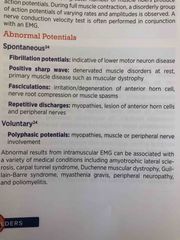![]()
![]()
![]()
Use LEFT and RIGHT arrow keys to navigate between flashcards;
Use UP and DOWN arrow keys to flip the card;
H to show hint;
A reads text to speech;
34 Cards in this Set
- Front
- Back
|
Wheelchair measurements |
Seat height 20 Seat depth 16 Seat width 18 Back height 16 Armrest 9 |
|
|
Two point gait pattern |
Using two crutches or canes |
|
|
Three point gait pattern |
Walker or crutches Advance AD, then injured, then uninjured |
|
|
Four point gait pattern |
Same as two point but everything separate |
|
|
NG tube |
Feeding, medication, or removing stuff from stomach |
|
|
Gastric tube |
Long term feeding |
|
|
Jejunostomy tube |
Tube into jejunum through ab wall |
|
|
IV |
Fluid source, clamp, pump, and catheter into vein |
|
|
Arterial line |
Measures BP or get blood samples Apply direct pressure if displaced and call for assistance |
|
|
Central venous pressure catheter |
Measuring pressure of right atrium or superior vena cava Evaluates right ventricular function, R atrium filling, and circulating blood volume |
|
|
Pulmonary artery (swan-ganz) catheter |
catheter inserted through being into pulmonary artery Measures continuous pulmonary artery pressure Avoid excessive upper movement |
|
|
Nasal cannula |
Up to 6L/min |
|
|
Oronasal mask |
Covers nose and mouth |
|
|
Chest tube |
Suction system to remove air fluid or pus from intrathoracic space |
|
|
Arteriography vs arthrography |
arteriography: X ray and injected contrast to visualize blood vessels Arthrography: same thing but for joints |
|
|
Bone scan |
Inject radionuclide and then scanned with gamma camera Identifies bone disease or stress fractures |
|
|
CT |
Non invasive X ray taken from multiple angles for 3D and cross section Higher doses of radiation |
|
|
Fluoroscopy |
Shows motion within body with x ray and injection of contrast |
|
|
Lumbar puncture |
Inserted into subarachnoid space |
|
|
MRI |
Good for soft tissue |
|
|
Myelography |
Combines x ray fluoroscopy or CT with contrast to evaluate spinal structures, specifically spinal cord, nerve roots, and meninges |
|
|
PET scan |
Uses radiography and injected radionuclide to determine metabolic activity or organ or tissue |
|
|
Heat transfer principles |
Conduction: direct contact like hot packs Convection: air or water moving like whirlpool Conversion: mechanic or electric energy absorbed into tissue like ultrasound Evaporation: liquid absorbs energy changing into vapor like biofreeze Radiation: radiation energy source like UV |
|
|
Hot and cold packa |
Hot: need 2-3 layers, 187-167 deg, 15-20 mins Cold packs: 25 deg, 20 min, up to 2cm in depth |
|
|
Paragfin |
113-122 deg, conduction Dip wrap: 6-10 dips then plastic bag Dip-reimmersion: 6-10 initial dips then stays in there Paint application: painted over body |
|
|
Ultrasound |
Up to 5cm depth, high frequency acoustic vibrations Thermal effects: increase metabolic rate, pain, muscle spasm, stiffness, circulation, soft tissue extensibility Nonthermal: cell and skin permeability, intercellular calcium levels, tissue repair, normal cell function 1Mhz = deeper tissues 3Mhz = superficial tissues Duty cycle: on time / on + off time |
|
|
Long stretch bandages |
Greatest resting pressure 60-70mm Hg Elasticity up to 200% Little working pressure For patients who are immobile |
|
|
Short stretch bandages |
Low rest pressure and high working pressure Used during exercise |
|
|
Multi layered bandages |
Mod/high resting pressure Mainly for venous stasis ulcers |
|
|
Semirigid bandages |
Treats venous stasis ulcers Wet gauze turn into hardened form Sustained compression 35-40mm Hg |
|
|
Compression garments |
Control edema, scar formation, improve venous circulation 16-18 mm Hg Help for DVT 20-30mm for scar 30-40mm for edema |
|
|
Electrotherapy - resistance |
Resistance = voltage/current |
|
|
Abnormal EMG |

Back (Definition) |
|
|
Massage techniques |
Effleurage: light strokes Friction: deep Petrissage: kneading, squeezes, rolled Tapotement: tapping cupping |

